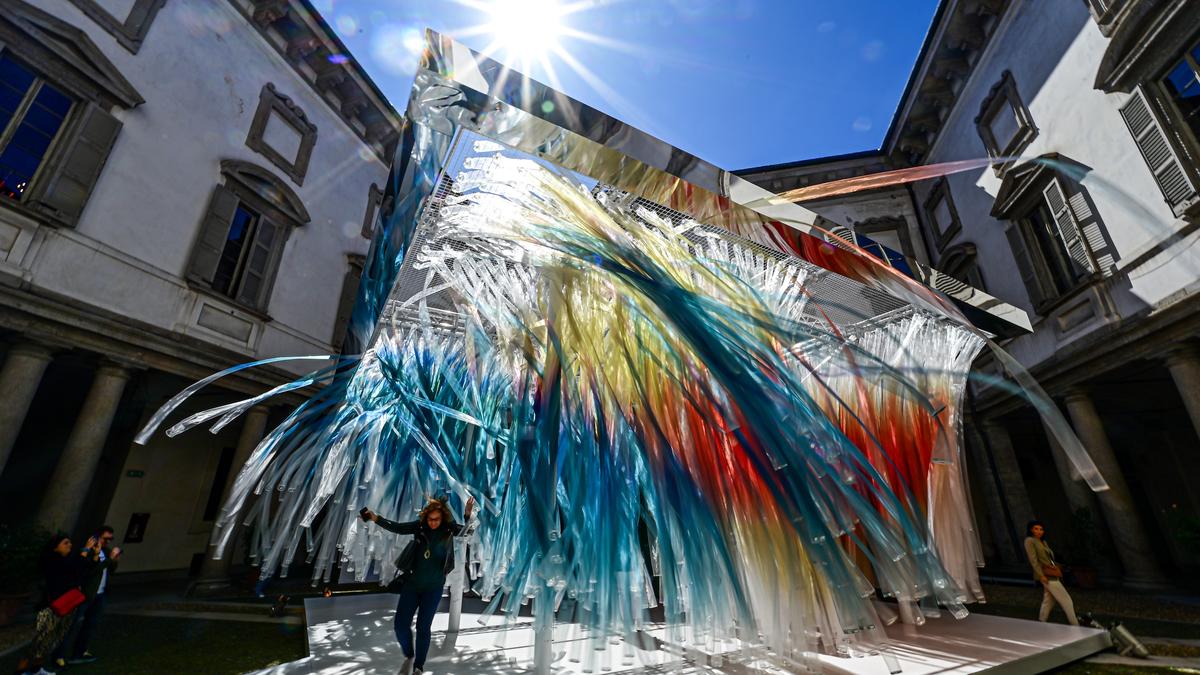
On a windy April day, we were at Baragaon in the languorous city of Guwahati, Assam. In the sky, a large bird flapped its wings slowly. It was the bird we were looking for; we moved in its direction. We went down a kaccha path and then turned right. The road ended in a towering garbage mountain.
It was an overwhelming sight. The garbage mountain was massive, with the solidity of a building or a monument. And it was alive. On thousands of kilos of plastic, food and solid trash, things were slowly moving. A cow chewed her cud, picked from the garbage. I wondered what she was eating, because the dominant feeling was poisonous. The stench was overwhelming, moving in pulses and waves like it wouldn’t mind socking us in the face. Plastic bags were everywhere, waiting to come alive on headwinds. Dust was omnipresent—some of it could have been the Brahmaputra’s silt, the rest was detritus. There was a haze in the air, but the birds and animals broke through the miasma and carried on their business. Kites did sorties in the air. Crows hopped about, suddenly taking off like smoke. And Greater adjutant storks moved ponderously through, their baby-pink neck pouches swinging like pendulums. Their gait had a certain gravitas, a sense of an inevitable closing of the loop. Greater adjutant storks were once the symbol of the municipality of Kolkata because they scavenged in garbage dumps. Decades ago, they soared in the skies with Gyps vultures, both looking for carcasses. Now, vultures are critically endangered, and Greater adjutant populations are much smaller in India—restricted to rural Bihar near Bhagalpur and rural parts of Assam and Guwahati.
The faces of the storks have a marbled, mottled pattern, like they are in various stages of decomposition. A proud kind of decomposition, a frankness that feels like a homage to their surroundings—to the bacteria and microbes that surround the discarded and rotting. This is amongst the world’s largest storks, and its beak is pale, the eyes bone-white. And behind the heads of the storks, there is a glistening pink portion. It looks like a brain. Two spots of colour stood out on the garbage mountain in that blistering, dusty place—the brain-like back of the stork’s head, and the floral yellow kurta of a young ragpicker going up the mountain. She walked with consummate ease, as if she was going up a rolling, grassy hill. A child shrieked, pausing mid-play with a friend, before tumbling on the brackets of the mountain. Sobered, she resumed her work of parsing through the trash. The stork nearby opened its great black wings—like a thundercloud on the horizon, seeming to shake off the shrieks of children playing. Just as easily, the bird tucked its wings back, all threats of an angry rumble abated. In a single foot of space, there was a cow, a person and a threatened stork. They seemed to have an old acceptance of each other.
But I am not trying to romanticise the lot of the waste-pickers and the towering storks in this place, full of cast-off memories. In 2017, 20 Greater adjutant storks were found poisoned in the garbage dump. Both the people who make their livelihood from the garbage and the bird need interventions. The people who parse through trash need health insurance, uniforms and dignity for the services they provide. And scavenging birds need safe sites to feed in. Scavengers dispose of animal waste in a natural way, and they should be able to access it without getting exposed to poisons. Guwahati’s garbage mountain leaches into its wetland sanctuary, Deepor Beel. But the storks often fish in the litter, not the water. One can argue these storks have always done this—but there are two facts of relevance here. The first is that over the decades, the range of the Greater adjutant stork has shrunk. At the same time, the toxicity of dumps is only increasing—the fish or meat the stork looks for in garbage will have chemical and e-waste next to it. What we urgently need is garbage segregation, and a study to see whether Greater adjutant storks will benefit from dedicated carcass dumping sites in the way vulture restaurants have been planned.
Many ecologists stress food waste should be separated from other kinds of waste. Many birds are likely affected by toxins in large garbage dumps, not just storks.
The second aspect I want to highlight is that wild birds don’t stick only to protected areas meant for their conservation. The Greater adjutant won’t stay only in the waters of Deepor Beel, like the Great Indian bustard won’t restrict itself to Rajasthan’s Desert National Park. There is thus a need to manage landscapes outside protected areas.
In March, the Supreme Court delivered an order on the protection of the Great Indian bustard’s (GIB) habitat. The GIB is a large bird of largely-overlooked dry and desert areas. An imposing bird with a loud call, it is one of the heaviest flying birds on earth. It has poor eyesight, and it dies on collision with large electric wires. Huge parts of the desert are now getting wind and solar energy plants, with kilometres of electric wires carrying them. The Supreme Court has modified its earlier April 2021 order which restricted electric wires in priority and potential GIB habitat. In a new order, the court has directed that a committee determine the scope of overhead and underground electric wires in GIB priority areas. The committee may add other suitable areas which are “crucial” for GIB conservation.
We need to safeguard GIB priority areas from wires; at the same time, we need to tackle the new wires that have come up in important GIB areas between the two court orders. We also need to secure movement areas of the GIB, such as the area between Khetolai-Sanawara-Rasla. With about 100 of the birds left in India, there is barely any time left.
As the saying goes, birds often fly free, though that “freedom” is adjudicated by the presence of toxins, and a reduced right of way in the sky.
That day, I watched as the Greater adjutant storks snapped their giant beaks, seemingly unable to separate intricate pieces of whatever they were eating. They must have swallowed things they didn’t want to. The Greater adjutant faces one of society’s oldest features—its cast-offs. And the bustard faces a new one: green power. Both birds are large, unconventional, and wilful—and both deserve nothing less than the very best application of mind from us.
Neha Sinha is a conservation biologist and author of Wild And Wilful: Tales Of 15 Iconic Indian Species. Views expressed are personal.
Source | Powered by Yes Mom Hosting





